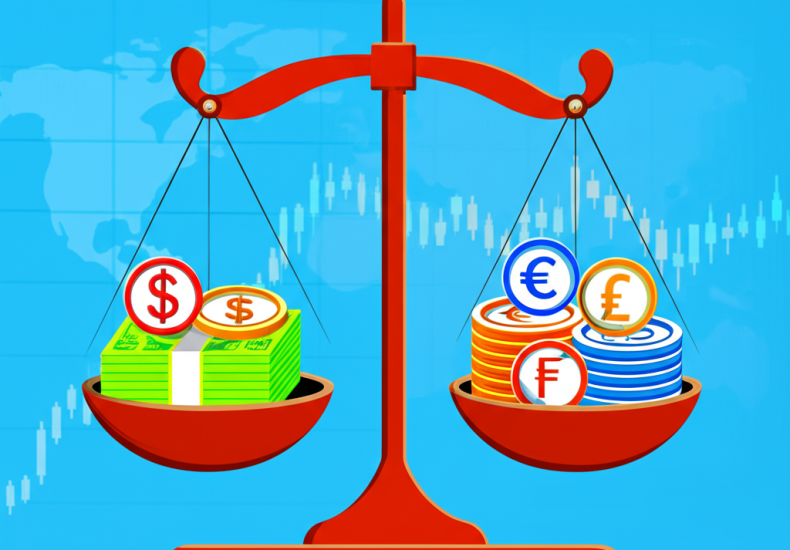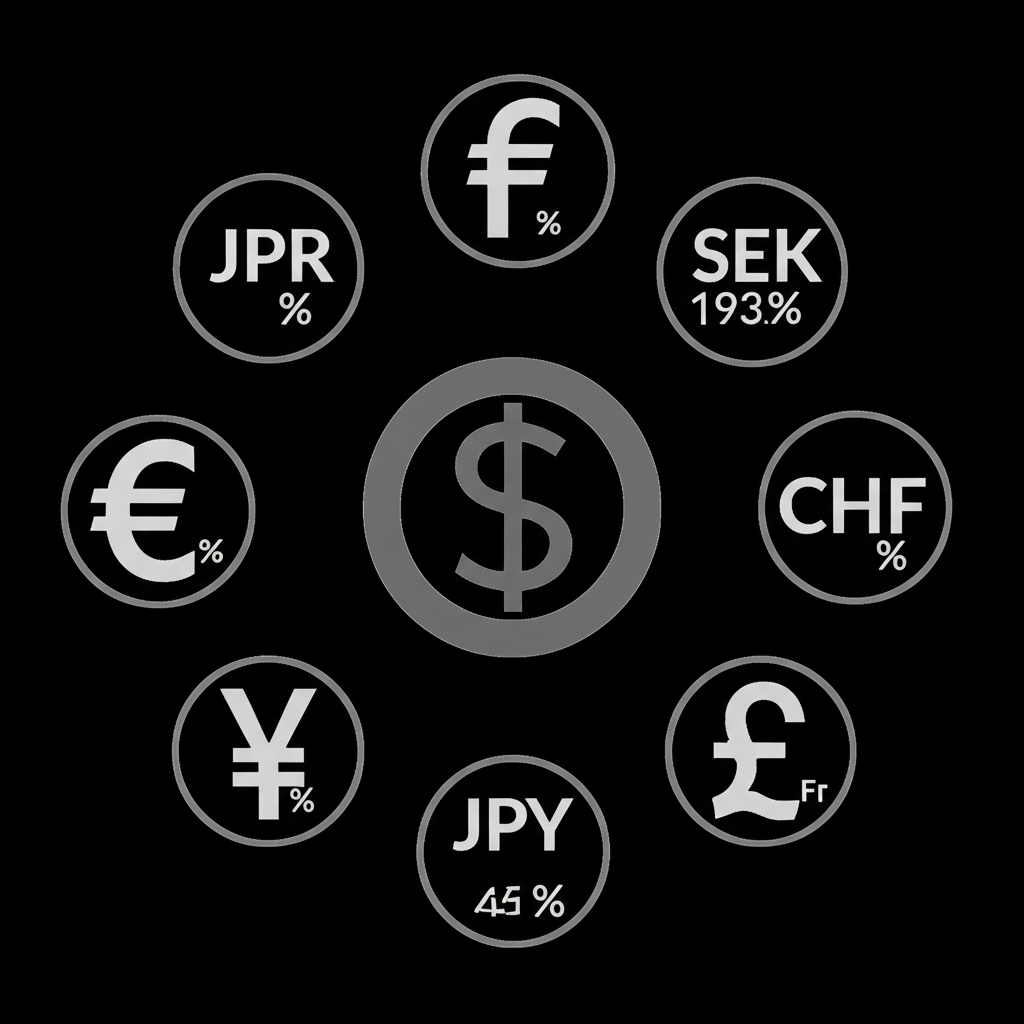
DXY Composition: Unpacking the 6 Currencies Driving the US Dollar Index
Table of Contents
ToggleIntroduction: What is the DXY and Why Does Its Composition Matter?

The US Dollar Index, commonly known by its ticker symbol DXY, serves as a cornerstone metric in the world of international finance. It reflects the strength of the US dollar against a carefully selected basket of six major foreign currencies. For investors, economists, and traders monitoring macroeconomic trends, the DXY offers a real-time pulse on the greenback’s global standing. Movements in the index can signal shifts in investor confidence, influence commodity pricing, and affect international trade flows. But to fully grasp what drives these movements, one must look beyond surface-level fluctuations and examine the structural foundation of the index: its composition. The specific currencies included—and their fixed weightings—aren’t chosen at random. They form the backbone of the DXY’s value, determining how it reacts to economic data, central bank decisions, and geopolitical developments across the globe.
A Brief History of the DXY: From Bretton Woods to Modern Markets

The creation of the DXY in 1973 was no coincidence—it arrived at a turning point in global economic history. That year marked the definitive end of the Bretton Woods agreement, which had anchored international currencies to the US dollar, itself tied to gold. When that system unraveled, countries shifted to floating exchange rates, creating a new need: a reliable benchmark to measure the dollar’s value in a more fluid and unpredictable environment.
Originally developed by the Federal Reserve, the index was later transferred to ICE Futures U.S. (formerly the New York Board of Trade), which continues to maintain and publish it. Its initial design aimed to reflect the dollar’s performance against the currencies of America’s most important trade partners at the time. Despite dramatic shifts in global trade—such as the rise of China, Mexico, and Southeast Asia—the DXY’s core structure has remained unchanged for decades. This consistency makes it a unique historical artifact, offering a continuous timeline of dollar valuation since the early 1970s, even as questions grow about its relevance in today’s more diversified global economy.
The Core Six: Unveiling the DXY’s Currency Composition and Weights

At the heart of the DXY lies a fixed basket of six currencies, each assigned a predetermined weight that dictates its influence on the index. This lineup has not changed since the Euro replaced national European currencies in 1999. The stability of this basket allows for long-term comparisons, but it also means the index reflects economic relationships from over half a century ago.
Euro (EUR): The Dominant Force
The Euro is by far the most influential component, accounting for 57.6% of the index. This heavy weighting stems from the fact that the Eurozone collectively represented a major share of US trade in the early 1970s. When the DXY was created, multiple European currencies—such as the German Mark, French Franc, and Italian Lira—were individually included. The Euro effectively consolidated their combined weight into a single currency. As a result, economic developments in the Eurozone, such as ECB interest rate decisions or German industrial output data, often trigger significant swings in the DXY, even if the dollar’s value against other currencies remains steady.
Japanese Yen (JPY): A Key Asian Component
Japan’s currency holds the second-largest position with a 13.6% weight. As the world’s third-largest economy and a major exporter, Japan has long been a critical US trading partner. The yen is also considered a traditional safe-haven asset, meaning it tends to strengthen during periods of market stress. This dual role means that movements in the yen often reflect not just bilateral trade dynamics, but broader global risk sentiment—such as during financial crises or equity market sell-offs—which in turn influences the DXY’s trajectory.
British Pound (GBP): Europe’s Other Major Player
The British Pound contributes 11.9% to the index, reflecting the UK’s historical economic significance and its deep financial ties to the United States. Although the UK left the European Union, the pound remains one of the most traded currencies globally. Its value is shaped by factors ranging from Bank of England policy to political stability in London, and even lingering Brexit-related uncertainties. Because of its weight, sharp moves in GBP/USD can noticeably impact the DXY, particularly during times of political or economic volatility in the UK.
Canadian Dollar (CAD): North American Influence
The Canadian Dollar makes up 9.1% of the basket, underscoring the close economic relationship between the US and Canada, which remain each other’s largest trading partners. The CAD is also considered a commodity currency, especially sensitive to oil prices due to Canada’s vast energy exports. This means the DXY can be indirectly influenced by shifts in crude oil markets—if oil prices fall, the CAD often weakens, which can cause the DXY to rise, even if the dollar itself isn’t gaining strength elsewhere.
Swedish Krona (SEK): Nordic Representation
At 4.2%, the Swedish Krona is a smaller but meaningful component. Sweden, while not as large economically as other nations in the basket, has long been integrated into European trade networks and maintains a highly developed, export-oriented economy. The krona’s movements are often tied to broader Scandinavian economic trends and European Central Bank policy spillovers, making it a subtle but relevant barometer of Northern European economic health.
Swiss Franc (CHF): The Safe-Haven Component
The Swiss Franc accounts for 3.6% of the index and is renowned for its role as a global safe-haven currency. Switzerland’s political neutrality, strong fiscal discipline, and world-class banking sector make the franc a preferred destination during times of global turmoil. While its weighting is relatively small, sharp inflows into CHF during crises can still affect the DXY, particularly when paired with risk-off behavior in global markets.
Full DXY Currency Basket and Weighting Table
To provide clarity, here is a breakdown of the DXY’s currency components and their fixed weightings:
| Currency | Weight (%) |
| :——- | :——— |
| Euro (EUR) | 57.6% |
| Japanese Yen (JPY) | 13.6% |
| British Pound (GBP) | 11.9% |
| Canadian Dollar (CAD) | 9.1% |
| Swedish Krona (SEK) | 4.2% |
| Swiss Franc (CHF) | 3.6% |
How the DXY is Calculated: Understanding the Geometric Mean
The DXY isn’t built using a simple average of currency pairs. Instead, it employs a geometric mean to calculate its value—a method particularly suited for currency indices. This approach reduces the distortion caused by extreme movements in any single currency and offers a more balanced reflection of overall dollar performance. By raising each exchange rate to the power of its respective weight and multiplying the results, the formula ensures that percentage changes are proportionally represented over time.
When the index launched in March 1973, it was set to a base value of 100. Today, a reading of 105 indicates the dollar has appreciated 5% against the basket since inception, while 95 suggests a 5% depreciation. This consistent benchmark allows investors to track long-term trends. The exact calculation methodology is managed and published by ICE Futures U.S., the official administrator of the index, ensuring transparency and standardization across financial markets.
Why These Currencies and Fixed Weights? Rationale and Criticisms
The DXY’s structure wasn’t arbitrary—it was rooted in the economic realities of the early 1970s. But as the global economy has transformed, so too has the debate over whether the index still serves its intended purpose.
The Original Rationale for Selection
The six currencies were chosen based on their importance to US trade during the 1970–1972 period. At the time, these were the most liquid, freely traded currencies from America’s top economic partners. The weights were derived from trade volume data, giving more influence to currencies from countries with which the US had the deepest commercial ties. This approach offered a stable, transparent benchmark in the uncertain early years of floating exchange rates. By locking in these weights, the index provided a consistent reference point, allowing analysts to compare dollar strength across decades without the noise of constant rebalancing.
The “Fixed Weight” Debate: Pros and Cons
While the fixed-weight model offers clarity and consistency, it also introduces limitations that grow more pronounced with time.
**Pros:**
* **Consistent Benchmark:** The unchanging structure enables direct comparisons over decades, making it ideal for historical analysis.
* **Predictable Impact:** Market participants know exactly how much each currency’s movement will affect the index.
* **Simplicity in Execution:** The fixed basket simplifies tracking and replication, especially for futures and ETFs tied to the DXY.
**Cons:**
* **Outdated Trade Representation:** The weights haven’t been updated to reflect current trade patterns. Today, countries like China and Mexico are among the US’s largest trading partners, yet they’re absent from the index.
* **Euro Overrepresentation:** The Euro’s 57.6% share effectively bundles multiple European economies into one currency, giving Europe outsized influence on the index compared to its current trade share.
* **Exclusion of Emerging Markets:** By focusing only on developed economies, the DXY misses major shifts in global growth and currency dynamics driven by emerging markets.
* **Static Design:** The lack of periodic rebalancing means the index doesn’t adapt to evolving economic conditions, potentially leading to misleading signals about the dollar’s true global strength.
DXY vs. Other Dollar Indices: A Broader View of Dollar Strength
Due to these limitations, alternative dollar indices have emerged, offering more dynamic and inclusive perspectives on the dollar’s international value.
The Bloomberg Dollar Spot Index (BBDXY)
The Bloomberg Dollar Spot Index (BBDXY) addresses many of the DXY’s shortcomings by incorporating ten currencies, including select emerging market currencies such as the South Korean won and the Mexican peso. Unlike the DXY, its weights are recalculated annually based on global trade flows, allowing it to reflect shifting economic relationships. This makes the BBDXY a more responsive and representative gauge of the dollar’s real-time strength in today’s interconnected markets.
The Federal Reserve’s Broad Dollar Index
For the most comprehensive view, the Federal Reserve’s Broad Dollar Index stands out. It includes 26 currencies, covering a wide range of developed and emerging economies—including China, India, Brazil, and Taiwan. Like the BBDXY, its weights are trade-weighted and updated annually, making it the preferred tool for policymakers and economists analyzing the dollar’s impact on inflation, trade deficits, and global capital flows.
When to Use Which Index?
Different indices serve different purposes:
* **DXY:** Best for technical traders, historical comparisons, and futures markets. Its stability makes it ideal for charting long-term trends and gauging sentiment in developed-market currencies.
* **BBDXY:** Offers a modern, balanced view with limited emerging market exposure. Useful for investors seeking a more current snapshot of dollar strength.
* **Federal Reserve’s Broad Index:** Most suitable for macroeconomic analysis, especially when assessing the dollar’s influence on US trade and inflation. Its wide scope provides the most holistic picture.
Implications of DXY’s Composition for Investors and Global Markets
The DXY’s heavy reliance on the Euro means its movements often reflect Eurozone conditions more than global dollar trends. For example, if the ECB raises interest rates while the Fed holds steady, the Euro may strengthen, causing the DXY to fall—even if the dollar is stable or rising against other currencies. This Euro-centric bias can mislead investors who interpret DXY declines as dollar weakness across the board.
This structural tilt has far-reaching consequences:
* **Commodity Markets:** A rising DXY typically pressures dollar-denominated commodities like oil and gold, as higher dollar values make these assets more expensive for foreign buyers. However, if the DXY rises solely due to Euro weakness, the impact on commodities may be muted.
* **Trade Competitiveness:** A strong DXY can hurt US exporters by making American goods more expensive abroad. Yet, if the strength is driven by European economic stagnation rather than US vitality, the real-world trade impact may be less severe.
* **Investment Strategy:** While many traders use the DXY as a quick sentiment gauge, sophisticated investors look deeper. For portfolios with exposure to Asia, Latin America, or emerging markets, relying solely on the DXY can create blind spots. Combining it with broader indices or custom currency baskets allows for a more accurate assessment of currency risk.
Conclusion: The Enduring Relevance (and Limitations) of the DXY
The US Dollar Index remains a vital tool in financial markets, offering a standardized, long-term measure of dollar performance. Its fixed composition provides continuity, making it invaluable for historical analysis and derivative trading. The dominance of the Euro within the basket ensures that developments in Europe have an outsized effect on the index, reinforcing its role as a barometer of transatlantic currency dynamics.
Yet, the world has changed dramatically since 1973. The DXY’s narrow, static basket fails to capture the full scope of US trade relationships, particularly with fast-growing economies in Asia and the Americas. As global financial markets become more interconnected, relying exclusively on the DXY risks painting an incomplete—or even distorted—picture of the dollar’s true strength.
For a well-rounded view, market participants should treat the DXY not as the definitive measure of dollar value, but as one piece of a larger puzzle. Supplementing it with more dynamic indices like the Bloomberg Dollar Spot Index or the Federal Reserve’s Broad Dollar Index allows for deeper insights and more informed decision-making. In an era defined by rapid economic evolution, the DXY’s value lies not just in its historical consistency, but in how thoughtfully it’s used alongside modern alternatives.
What are the six primary currencies that make up the DXY?
The six primary currencies in the DXY basket are the Euro (EUR), Japanese Yen (JPY), British Pound (GBP), Canadian Dollar (CAD), Swedish Krona (SEK), and Swiss Franc (CHF).
How do the fixed weights of the DXY’s currency basket impact its accuracy as a dollar strength indicator?
The fixed weights mean the DXY doesn’t adapt to changing global trade patterns, potentially making it less representative of the dollar’s true strength against its current major trading partners. The Euro’s dominant weighting also means its movements disproportionately influence the index.
What is the significance of the Euro’s dominant weighting in the DXY?
The Euro’s 57.6% weighting means that economic or monetary policy developments in the Eurozone have the largest impact on the DXY’s value. This can cause the DXY to move significantly even if the dollar’s strength against other non-Euro currencies remains relatively stable.
Why was the DXY created in 1973, and how has its purpose changed over time?
The DXY was created in 1973 following the collapse of the Bretton Woods system to provide a benchmark for the dollar’s value against major currencies under a floating exchange rate regime. While its purpose as a benchmark remains, its relevance as a comprehensive indicator of global dollar strength is now debated due to its outdated composition.
Can the composition of the DXY index ever be changed, and if so, how?
While theoretically possible, the DXY’s composition has only been significantly altered once, in 1999, to incorporate the Euro. Changes would require a decision by ICE Futures U.S., which administers the index, and would likely be met with debate due to its historical status.
How does the DXY’s calculation (geometric mean) differ from other currency indices?
The DXY uses a geometric mean, which is appropriate for currency indices as it smooths out volatility and prevents extreme fluctuations from disproportionately impacting the index. Some other indices might use arithmetic means or different weighting methodologies.
What are the main criticisms leveled against the DXY’s current composition?
Main criticisms include:
- Its fixed weights do not reflect current global trade flows.
- It excludes major trading partners like China and Mexico.
- Its narrow basket doesn’t provide a comprehensive view of global dollar strength.
- The Euro’s dominant weighting can skew its representation.
How does the DXY compare to the Bloomberg Dollar Spot Index (BBDXY) in terms of composition and methodology?
The BBDXY uses a broader basket of ten currencies, including some emerging market currencies, and its weights are dynamically adjusted based on trade flows, typically annually. In contrast, the DXY has a fixed basket of six currencies with static weights.
What role does the DXY play for forex traders and global investors?
For forex traders, the DXY serves as a quick gauge of dollar sentiment and a tool for technical analysis, often used as an inverse indicator for commodity prices. Global investors use it as a benchmark, though many recognize its limitations and consider other indices for a broader perspective on dollar strength and risk management.
Does the DXY include any emerging market currencies, and if not, why?
No, the DXY does not include any emerging market currencies. Its composition is limited to six major developed market currencies, primarily reflecting the US’s trading relationships from the early 1970s. This is a key reason why alternative indices have been developed.
You may also like
Calendar
| 一 | 二 | 三 | 四 | 五 | 六 | 日 |
|---|---|---|---|---|---|---|
| 1 | 2 | 3 | 4 | 5 | 6 | 7 |
| 8 | 9 | 10 | 11 | 12 | 13 | 14 |
| 15 | 16 | 17 | 18 | 19 | 20 | 21 |
| 22 | 23 | 24 | 25 | 26 | 27 | 28 |
| 29 | 30 | 31 | ||||
發佈留言
很抱歉,必須登入網站才能發佈留言。